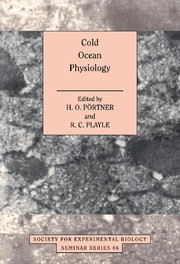Book contents
- Frontmatter
- Contents
- List of contributors
- Preface
- PART I General concepts
- PART II Compensatory adaptations in cold ocean environments
- Adaptation to cold and depth: contrasts between polar and deep-sea animals
- Temperature and growth rates as modulators of the metabolic capacities of fish muscle
- Energetic aspects of cold adaptation: critical temperatures in metabolic, ionic and acid-base regulation?
- Physiological and evolutionary aspects of myoglobin expression in the haemoglobinless Antarctic icefishes
- Oxygen transport systems in extreme environments: multiplicity and structure-function relationship in haemoglobins of Antarctic fish
- Membrane lipid and protein adaptations in Antarctic fish
- Kinetics of enzymes in cold-stenothermal invertebrates
- Effects of low temperature on prooxidant processes and antioxidant defence systems in marine organisms
- PART III Exploitative adaptations
- PART IV Integrative approaches
- PART V Applied approaches
- Index
Membrane lipid and protein adaptations in Antarctic fish
Published online by Cambridge University Press: 13 March 2010
- Frontmatter
- Contents
- List of contributors
- Preface
- PART I General concepts
- PART II Compensatory adaptations in cold ocean environments
- Adaptation to cold and depth: contrasts between polar and deep-sea animals
- Temperature and growth rates as modulators of the metabolic capacities of fish muscle
- Energetic aspects of cold adaptation: critical temperatures in metabolic, ionic and acid-base regulation?
- Physiological and evolutionary aspects of myoglobin expression in the haemoglobinless Antarctic icefishes
- Oxygen transport systems in extreme environments: multiplicity and structure-function relationship in haemoglobins of Antarctic fish
- Membrane lipid and protein adaptations in Antarctic fish
- Kinetics of enzymes in cold-stenothermal invertebrates
- Effects of low temperature on prooxidant processes and antioxidant defence systems in marine organisms
- PART III Exploitative adaptations
- PART IV Integrative approaches
- PART V Applied approaches
- Index
Summary
The success of Notothenioids to survive in the Antarctic involves, among other things, adaptive modifications of proteins and membrane lipids, because only the conservation of their biochemical characteristics and physiological state allows physiological processes to proceed at the low temperature of the Antarctic sea.
Biological membranes are complex structures whose composition (mainly lipid and protein) and arrangement vary widely both between, and within, cells depending upon function (Gennis, 1989).
The phospholipid bilayer holds multiple essential properties for cell membrane function since it:
(i) acts as a physical barrier to solute diVusion;
(ii) regulates the utilization of energy in transmembrane ion gradients;
(iii) mediates the transmembrane movement of specific solutes;
(iv) provides an organizing matrix for the assembly of multicomponent metabolic and signal transduction pathways;
(v) supplies precursors for the generation of lipid-derived second messengers.
Biological membranes may contain different types of proteins related to different cellular functions such as transmembrane transport (channels and carriers), substrate hydrolysis (enzymes), hormone and neurotransmitter recognition (receptors) and protein contributions to the mechanical structure of the membrane. Membrane proteins may be associated with the lipid bilayer in different ways. They have been distinguished as peripheral or integral proteins according to whether they penetrate to a lesser or greater extent into the bilayer and can therefore be isolated by mild or more severe treatments.
The amount of lipid in biological membranes ranges between 20 and 80% of the dry weight and, because of the lipids, particular structural and physical properties of the membrane occur.
- Type
- Chapter
- Information
- Cold Ocean Physiology , pp. 166 - 189Publisher: Cambridge University PressPrint publication year: 1998
- 16
- Cited by

